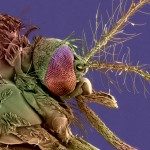Link to Pubmed [PMID] – 12510901
Med. Vet. Entomol. 2002 Dec;16(4):456-60
Population genetics of peri-domestic Aedes aegypti (Diptera: Culicidae), vector of dengue and yellow fever, were investigated by gel electrophoresis of 10 enzyme loci in 14 samples of mosquito larvae collected in 1997-1998 from localities separated by distances of 3-275 km in French Guiana. Genetic differentiation between geographical populations was generally high (mean FST = +0.111, P < 10(-5)) even among seven sites <30 km apart (FST = +0.137, P < 0.05), but not positively correlated with distance. Thus, Ae. aegypti comprises a mosaic of genetically differentiated populations in French Guiana. This may be attributed to reinvasion from diverse origins through repeated founder events after this vector species was eliminated during the 1940s to 1960s.
